| HAMPSHIRE - 2 |
 |
Michelmersh - St Mary |
 |
| Church open normal
hours. Church open O/S Ref: SU 347 266 |
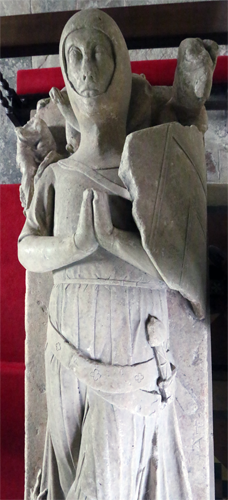 |
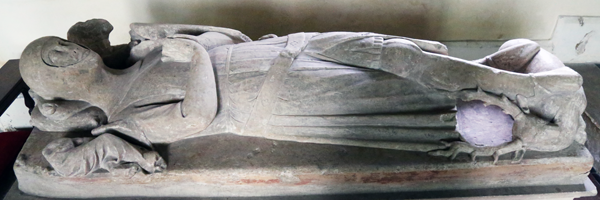 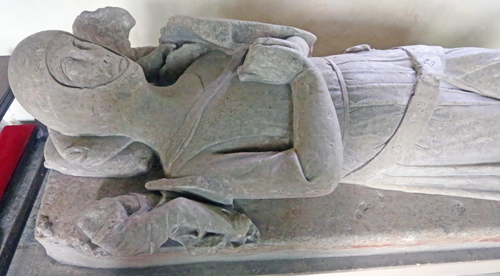 |
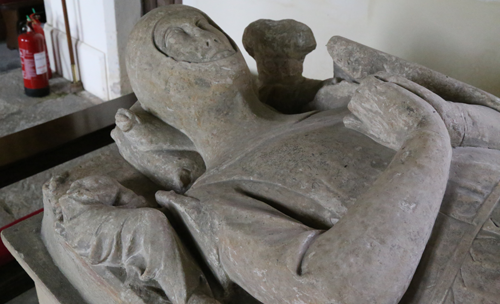 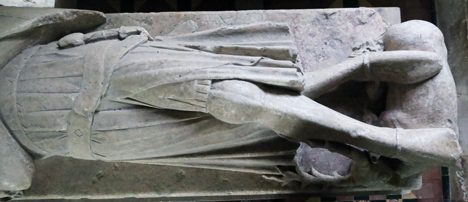 |
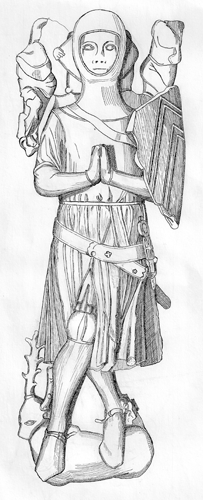 |
  |
|
This effigy now rests on a modern chest on
the north side of the chancel. It is in fairly good condition
and shows some remains of painting. The heraldry on the shield
is carved in relief. There are no signs of the mail being
carved. Note the quilted garment just showing underneath the
mail shirt. It is though to be of Sir Roger Woodlock
(c.1320), nephew of the Bishop of Winchester. Until
2020 it was thought to be of Sir Geoffrey de Conterton. There are two unusual features of this effigy: the feet rest on a stag (best seen column 2, row 1) .There are aitlettes, a short lived possibly heraldic device, on the shoulders, now fractured. Best seen column 2, row 2 and column 3, row 1) These are slightly broken but lie between the angel and shoulder |
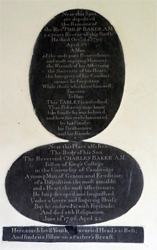 |
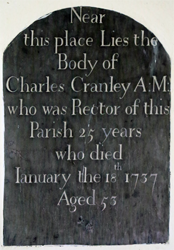 |
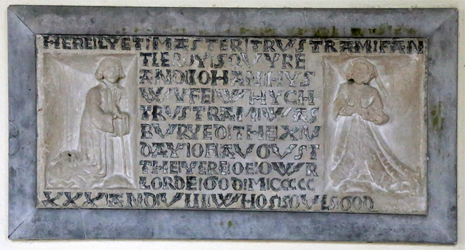 |
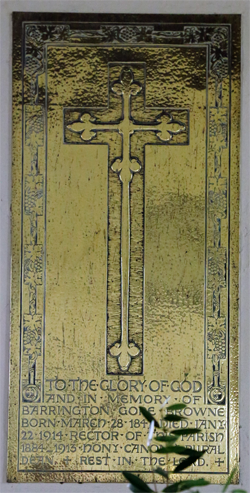 |
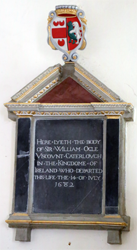 |
Top: Rev Philip Baker MA (1796) Rector. Below: Both of the tablets are to the son of the above: Rec Charles Baker AM (1766) Fellow of King's College. 'He long drooped and languiſhed under a ſevere and lingering illneſs' |
Charles Cranley AM (1737) Rector 25 years |
Trustram Funeleroy (1538) | Barrington
Gore Brownen (1914) Rector, Hon Canon, and Rural Dean. |
Sir William Ogle, Viscovnt Caterlovgh (Ireland) (1682) |
| Other Monuments | |
| Joanna Woodcock (1813) Age 3. Daughter of Rev Henry Woodcock | Oval tablet, white with black border, long axis horizontal |
| Rev John Pierce Maurice (1874) 33 years rector. Also Atherton Powys Maurice (1865) Lt 91st Highlanders. He died on board on passage home from India; buried at Suez. | Rectangular black tablet. Long axis vertical |
| William Elderfield (1831) | All oval with long axis horizontal; white tablets with black border. Some are worn and partly illegible. |
| Mary Elderfield (1839) Wife of the above | |
| Elisabeth Goffe (1838) | |
| Ruth Goffe (Wade) (1800) | |
| William Goffe | |
| Henry Wheable and his wife Jane (1839) Also thier son, John (1837) | White tablet on black backing, pediment |
| Sarah Wheable (1845) Wife of Thomas | White tablet on black backing |
| Caleb Smith (1805) and his wife, Sarah (1801) | White tablet with draped urn atop. Obbelisk. |
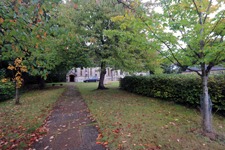 |
Netley - St Edward the Confessor |
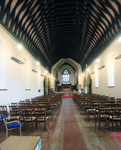 |
| Follow the signs not to Old Netley
but rather to Netley Abbey, the town of Netley
having tagged Abbey onto its name, in the manner of the
Burgundian wine growing villages. There is a ruined
abbey on the edge of town. If you follow the coast road
north-west (Victoria
Road) then turn right, going north-ea.st,
along (Grange
Road) the church is on
the latter road on the left. If you reach the actual abbey on
right along Victoria Road, you have gone too far: turn before
you reach the abbey. The church is locked so you will need
prior permission to visit. Past the church there is a gate leading to
the church car park. O/S Ref: SU 454 098 |
 |
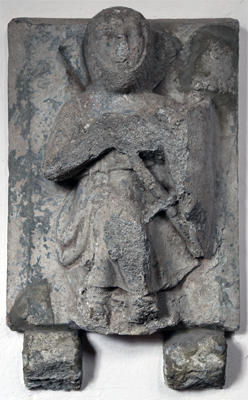 |
 |
| A minature knight, now cemented into the wall | ||
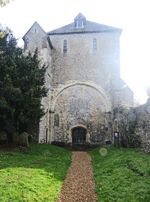 |
Pamber Priory Also known as: West Sherborne Priory |
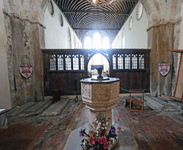 |
| The church is locked;
to visit contact the parish administrator whose address is given on the
church
website. A very friendly reception. Park outside. To find: Best to get a 1:50,000 O/S map. On a Sat Nav aim for Pamber End, which is on the A340, but Pamber Priory is not in this village nor in any village; there is a yellow road which leaves and returns to the A340 on either side of Pamber End. Take this road and then leave it to the east on a white road marked to the church and to Priory Farm. O/S Ref: SU 609 582. |
| In the early 1100's one Henry de Port
applied to King Henry I for permission to build a Benedictine
Priory as a daughter house of the
Abbey of St Vigors at Cerisy la Forest (near Bayeux in
Normandy), in other words an 'alien priory'. An alien
priory is a daughter house of a foreign abbey. This
practice dated back at least to 912, although it increased
considerably after the Norman Conquest of 1066 when the Duke of Normandy
became also King of England and landholders held possessions on both
sides of the English Channel. This practice allowed a few monks to
administer the distant estates of a mother house and to
send the profits from the estates of the daughter house to
mother house In 1294 when King Edward I was at war with France about 100 alien priories were seized by the crown so that their revenue could be used by the King for the war as well as to prevent foreign monks in coastal areas giving help to a foreign invader. His grandson Edward III restored many or these alien priories to their original owners but confiscated them again when was broke out with France. By the time of the reign of his grandson Richard II most were in royal hands and during his reign in 1378 all foreign monks were expelled from England. In 1414 under King Henry V all the alien priories were finally suppressed. Pamber Prior seemed to have escaped this suppression and was given in 1451, with other properties, to Eton College by the latter's founder King Henry VI. A year later Eton College expelled the prior and the remaining five monks, sold off any valuables and began to demolish the buildings. Ten years later the local population appealed to the new king, Edward IV, who took the Priory from Eton College and gave it to St Julian's Hospital Southampton, a possession of Queen's College, Oxford, who restored the buildings which were reconsecrated in 1474. Eton college went to law to recovery the Priory losing the final appeal in 1499. After 1558 the Priory again fell into disuse and was used as an agricultural store. Again the local populace appealed, this time to Chancery who ordered Queen's College to maintain the church in a fit condition. Queen's College still own Pamber Priory. The building we see today is just the chancel of the original church (with some stonework): the filled in chancel arch can be seen in the photograph above. |
 |
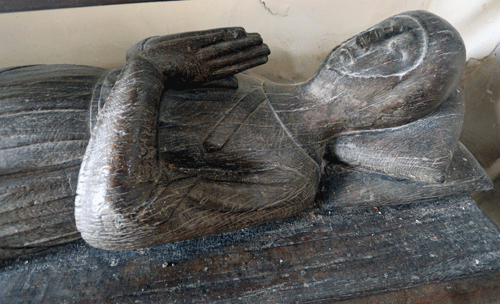 |
 |
|
 |
| Wooden (probably oak) effigy of a knight. Again
there is no sign of mail carving. Although there is
what looks like a belt to hold the shield, I could
not detect any sign of the latter. It is seven feet
in length.
I do not know the original position of this effigy
although it is somewhat more decayed on the right
side than the left, possibly indicating it was once
placed in a niche against a wall. When I visited the
church in the 1970's the effigy was locked in the vestry following
a number of thefts in the region, especially that of
a wooden effigy in Burghfield. With the Rector
I
lifted the effigy into the body of the church and
we were able to examine the underneath: this had been
considerably hollowed out, probably to contain
charcoal to dry out the wood. It certainly made the
effigy easy to lift. Although I
photographed the effigy at that these photographs are lost but I did
do some sketches which I have reproduced here. The effigy is now placed in a niche protected by an iron cage secured by two padlocks. The church warden holds one of the keys but it seems like the other key is now lost. There is in iron bar above the effigy so it cannot be lifted out but neither can it be photographed from the top. |
 |
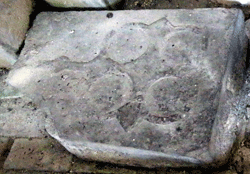 |
 |
 |
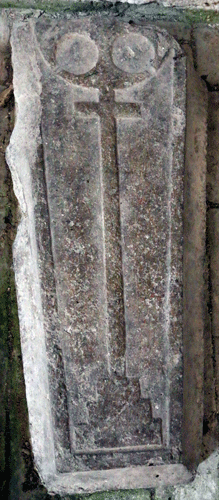 |
 |
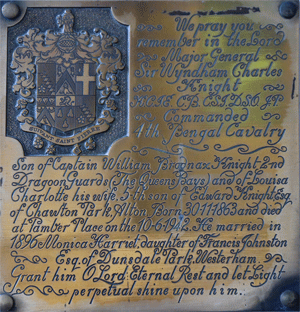 Above: Lord Major General Sir Wyndham Charles Knight HCI CB CSI DSO JP (1942) He commanded the 4th Bengal Cavalry Also: Elizabeth Hungerford (2005) Gray tablet Peter Bromhead (1989) Church Warden. Brass |
| A series of grave covers from late 12th to the first half of the 13th centuries; probably of members of the founders family or early priors. One has an often met inscription, written in rhyming Latin verse, which when translated reads: ' Whoever you may be who who passes by, stop, read carefully, lament. I am what thou wilt be and I was what thou art. For me I pray you pray.' There is no name of whom to pray for! | |||
| Oakley - St Leonard |
 |
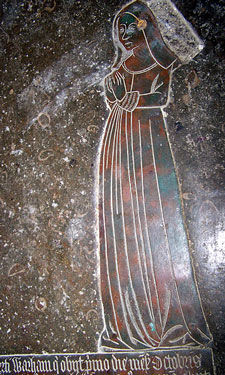 |
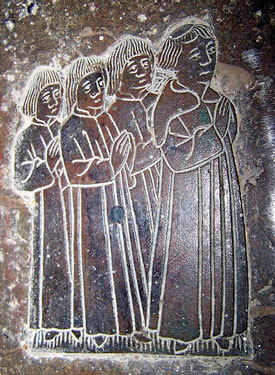 |
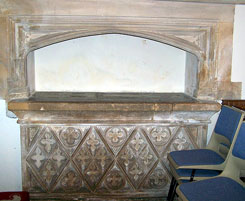
'Pray for the soul of Robert Warham who
died 1st October 1487 and Elizabeth
his wife who died the same year on the fifteenth day of
September. May God receive their souls. Amen.'
Parents of William, Wareham, Archbishop of Canterbury 1450-1532 |
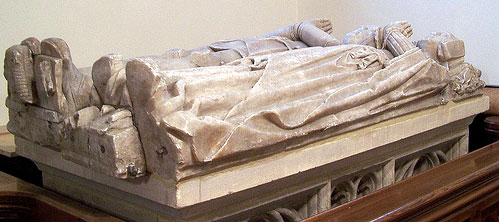 |
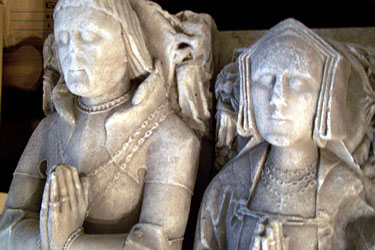 |
| Hugh Wareham, 3rd son of the above, and Maryon (Colles) c 1520 Alabaster | |
|
Portchester St Mary |
 |
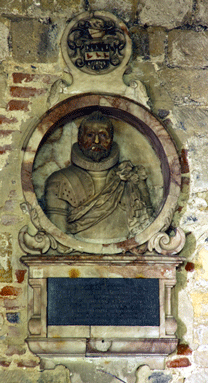
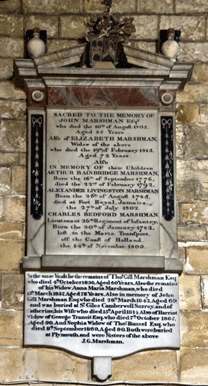
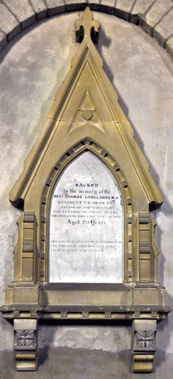
From Left to Right: James Lind MD (1794)
and his 'relict' Isabel Dickie (1797); the
latter section has been added by T.
King of Bath and obscures the
sculptor's name of the upper part.
Sir Thomas Cornwallis (1618) By Nicholas Stone John Marshman (1805); his widow Elizabeth (1815); their children Arthur Bainbridge (1792), Alexander Livingstone (1798) and Lt Charles Bedford (1805). Added below: 'In the same vault...' Thos. Gill Marshman (1836); his widow Anna Maria (1857); also 'in memory of ' John Gill Marshman 'buried at St Giles, Camberwell', his wife Catherine (1814) ; also sisters of J.G Marshman: Harriet Transit (1867) & Sophia Russle (1869). Both buried at Plymouth. Rev Thomas Longland MA (1856) Vicar |
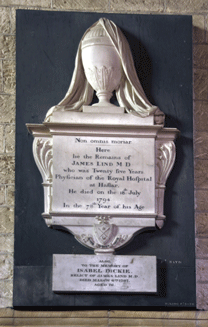 |
||
| Tablets | |
| Daniel Moore (1830); his wife Elizabeth (1849) and her sister Mary Gilles (1839) White tablet | Frances Mary Tinling (1819) White tablet |
| Agnes Stares Wilkinson (1847) and husband John Walter Wilkinson (1855) White tablet, black backing, scolly pediment | |
| Romsey Abbey |
 |
|
| Park in nearby car parks, long and short
stay; short stay is £1 per hour. The Abbey is open, entry is free and well
staffed. Photography is allowed and a donation is politely
requested. Romsey Abbey was a Benedictine Nunnery founded in the 10th Century. O/S Ref: SU 351 212 |
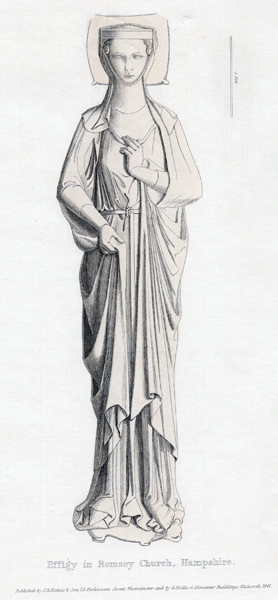 |
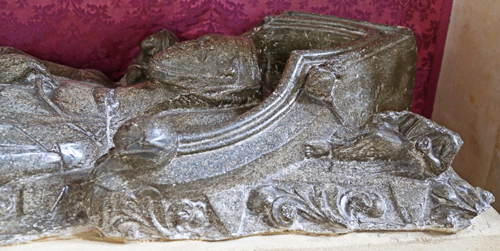 |
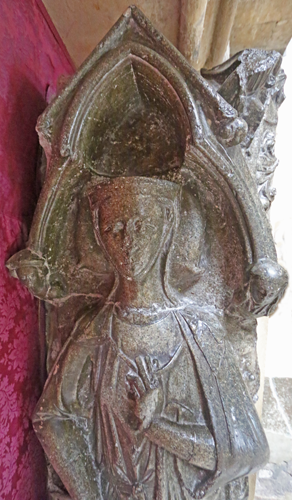 Unknown lady, 13th century Purbeck Marble |
 |
||
 |
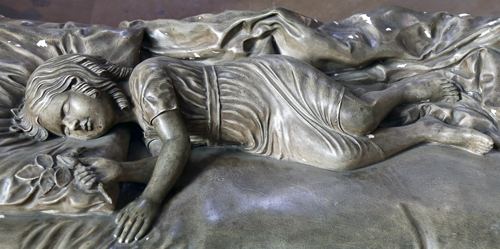 Alice Taylor (1843) She died of scarlet fever aged two years and five months. |
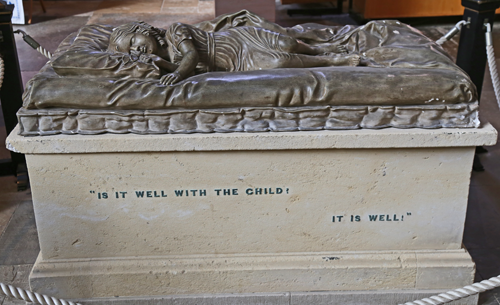 |
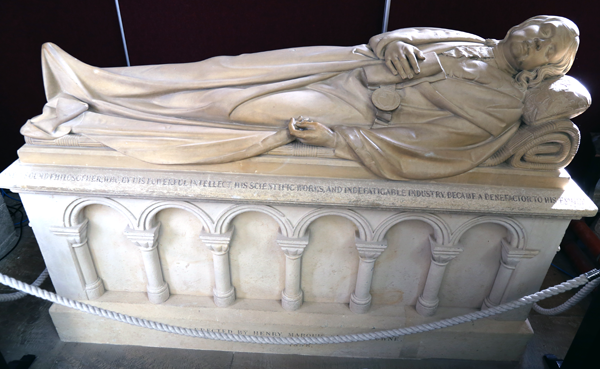 |
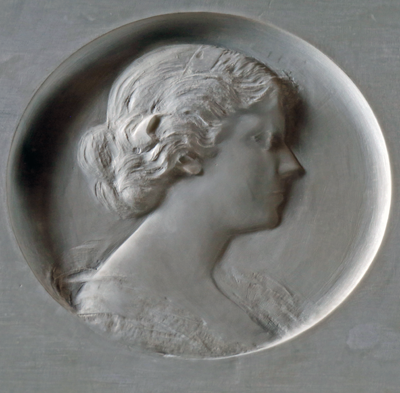
|
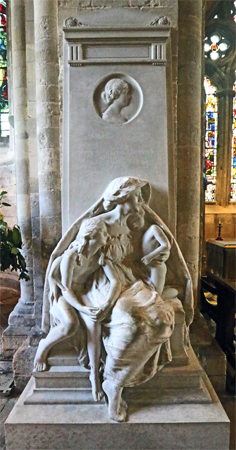 |
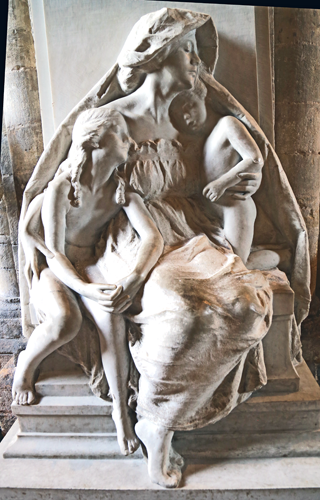 |
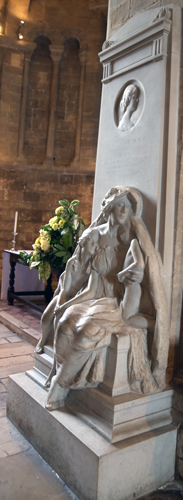 |
|
|
|
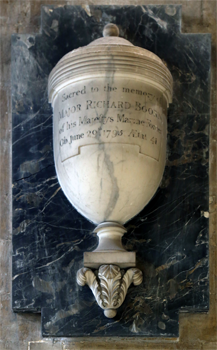 |
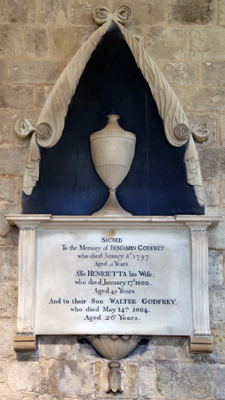 |
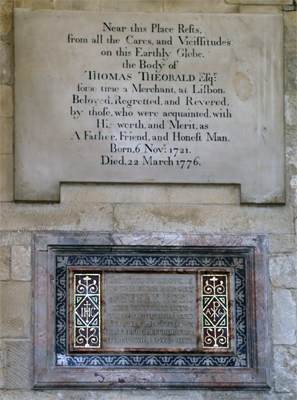 |
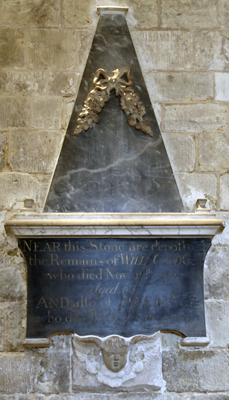 |
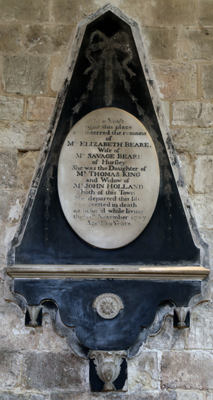 |
| Major Richard Boo__ (Booth?) (1795) | Benjamin Godfrey (1797), his wife, Henrietta (1800) and their son, Walter (1804) | Top: Thomas Theobald (1776) 'ſome time a Merchant, at Liſbon' Bottom: Records the window above was erected in memory of Susan Noel (1890) |
William Good (1762) and his wife Jane (1772) |
Henrietta Beare (King) (1798) Wife of Savage Beare |
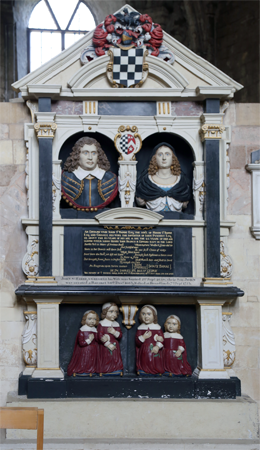 |
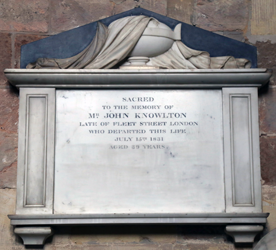 |
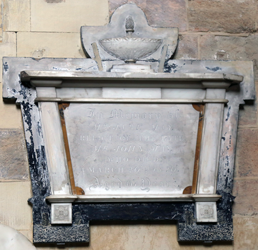 |
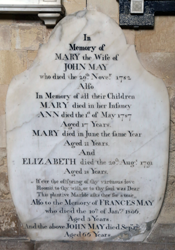 |
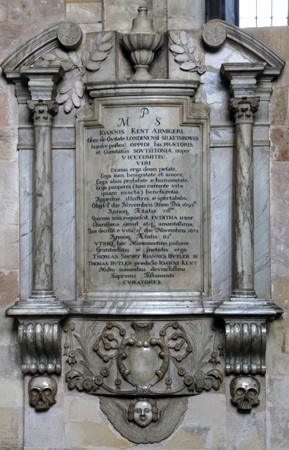 |
| Left: John St
John Barbe & Wife (1658). Above left:
Mr John Knowlton (1883) 'late of Fleet Street, London'.
Above centre: Mrs Jane May (1826).
Above right: Mary May (1782), the
wife of John May; their children: Mary (died in
infancy), Ann (1787) aged 17, Mary
(1787) aged 11, Elizabeth (1791) aged
18. Also Frances May (1806) aged 3. And the
above mentioned John May [18]08.
Right: John Kent (1692) Below: Admiral of the Fleet Earl Mountbatten of Burma (1900-1979) Assassinated with his grandson and two others |
||||
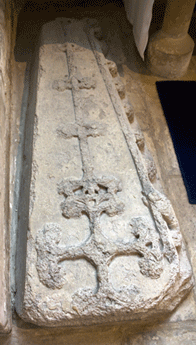 |
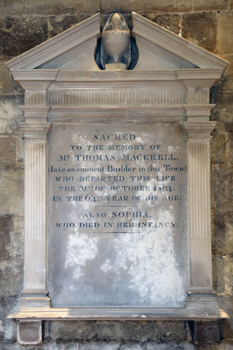 |
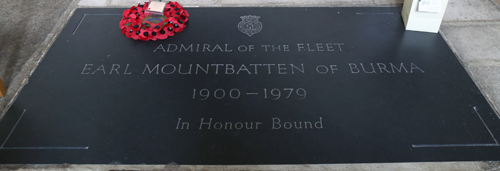 |
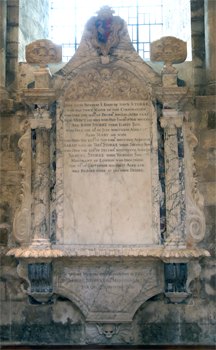 |
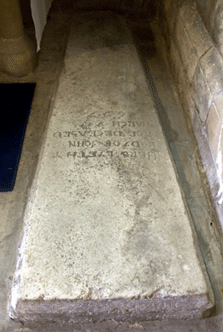 |
|
Left: Mr Thomas Mackrell
(1804) (late an eminent Builder in the Town). Also
Sophia who died in her infancy. Far left: Abbess Ӕthelflæda was the 4th abbess appointed in 1003 Right: John Storke (1711), 'twice Mayor of this Corporation'; his wife Marcy (1711); their eldest son, John (1723), and his wife, Mary (1724); Sarah (1737), wife of Thomas, their second son; Samuel Storke (1746), 'Merchant of London', their youngest son, 'was buried here at his own desire.' Far right: John Pole (1657) |
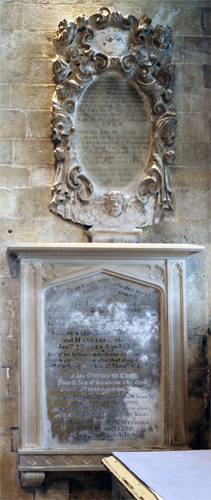 |
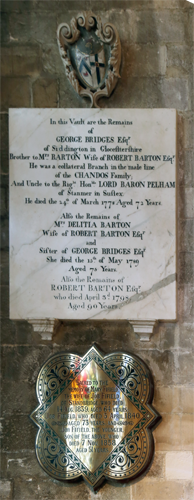 |
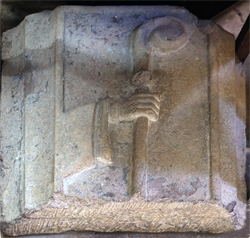 |
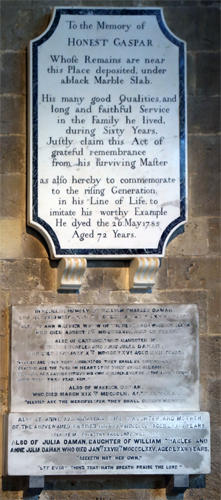 |
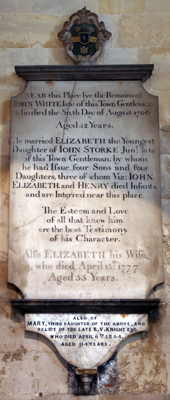 |
| Far left: Rev
William May__ Polshot (1727). For 30 years vicar of
this parish; and his wife, Elizabeth Polshot (Gollop)
(1722). Below this: Godwin
Withers (1829); his infant son, Seward
and his daughter, Margaret (1829) aged 3; also
his fourth son, Gustavus Keet (1839) aged 19;
also Josiah 'supposed to have been drowned at
sea about 1830; also his eldest son Godwin (1883);
also Mary Elizabeth Withers (1886), who lived
to 96. Left: 'In this Vault are the
Remains of...' George Bridges Eſq
(1778) 'He was a
collateral Branch in the male line the CHANDOS Family.' Also his
sister Delitia Barton (Bridges) (1789); and the
latter's husband Robert Barton (1798).
Below this is a brass: Mary Fifield (1839);
her husband, Job Fifield (1846); their younger
son, also, Job Fifield (1858). Above:
Upper part of broken slab with a hand holding a crosier
carved in relief. Left: Honest Gaspar (1785). Below this is the somewhat complicated: William Charles Daman (1844); also Ann Warrick (1818), widow of Rev Thomas Warwick, Clerk; also, Caroline (1826), aged 17, daughter of William Charles & Anne Julia Daman; also Warrick Daman (1852); also Anne Julia Daman (1856) 'wife, daughter and mother of the above'; also Julia Daman (1875), daughter of William Charles & Anne Julia Daman. Far left: John White (1776), his wife Elizabeth (Storke) (1777).They had four sons and four daughters of whom John, Elizabeth & Henry 'died as Infants and are Interred near this place.' Below on an extension is added: their third daughter, Mary Knight (1834) |
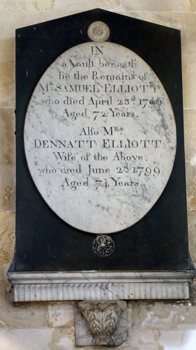 |
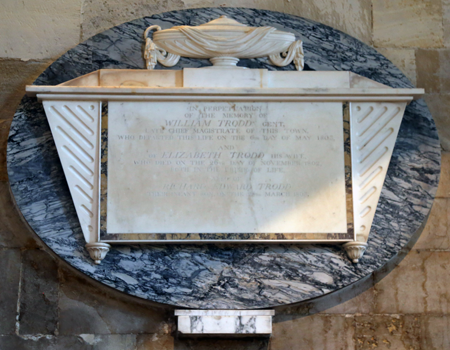 |
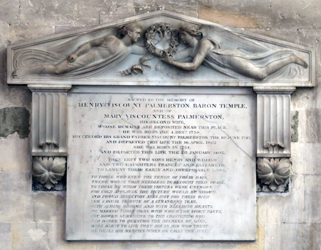 |
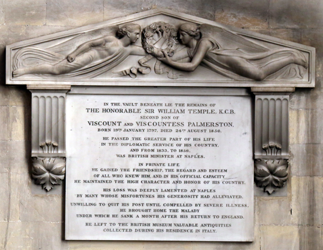 |
|
| Left: Samuel Elliot (1796), his wife Dennat Elliot (1799) Above left: William Trodd (1803) 'chief magistrate of this town'; his wife Elizabeth (1802) and their infant son Richard Edward (1803). Above centre: Henry Viscount Palmerstone Baron Temple (1802) and his second wife, Mary, Viscountess Palmerstone (1805) Above right: The Hon Sir William Temple KCB (1853), Second son of Viscount and Viscountess Temple. | ||||
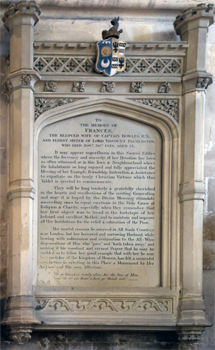 |
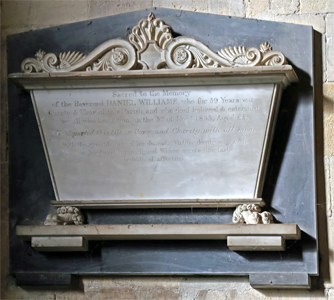 |
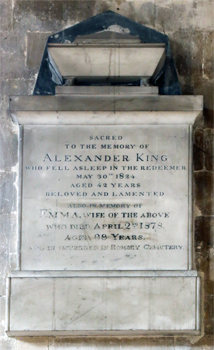 |
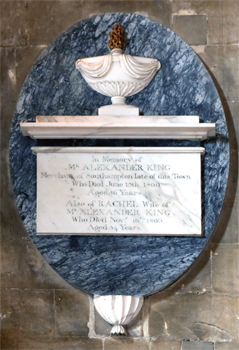 |
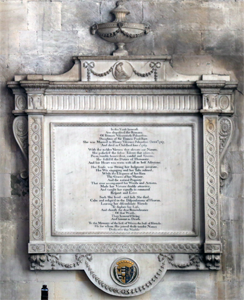 |
| Frances Bowles (1838) | Rev Daniel Williams Curate and Vicar of this parish for 59 years. He died 1835 aged 85 |
Alexander King (1824) His wife Emma (1879) |
Alexander King (1800) 'Merchant of Southampton late of this Town' His wife Rachel (1806) |
Frances Viscountess Pamerstone (Poole) (1796) |
| More Monuments | ||
Isabella Dutton (Mansfield) (1895) White oval (long axis vertical) tablet. John Hedges (1807) & his wife Josina (1810) White oval tablet on light brown oval base Richard Webb (1836) White rectangular tablet with gable. Thomas Nodes (1790) Aged 18. White oval tablet with long axis vertical Rev Charles Hickson BA White tablet Ann Brusby (1818) White oval tablet John Bartlett (1817) The white tablet records that 'By the Union of great Medical ſkill and unwearied Induſtry he acquired a conſiderable fortune' which he left 'chiefly for charitable purposes. 'This chapel was fitted up for Divine Service Susan widow of the Hon. and Rev. Gerard T Noel MA, formerly Vicar of the Parish.' Brass Capt Anthony Hebry Evelyn Ashley, Coldstream Guards. He died in 1921, aged 27, from wounds received at Ypres 1916. Gray tablet with military badge and floral cornice. George Bright Footner (1912) and his wife, Emily Footner (1911) White tablet with raised border. 2nd Lt Arthur Henry Footner, 1st Batt, Essex Reg. Grandson of the above. 'untimely killed while leading his men on an assault on a Turkish Trench near Capes Helles on 6th April 1915. Aged 27. White marble tablet on black marble base, with military badge. Henry Footner (1911), Katharine Footner (1918), Mary Charlton Footner (1927) Black tablet with white border. Mariana Longcroft (1760) 'After a life of 26 Years' Oval tablet, long axis vertical, white with black border. John Latham MD (1838) White tablet with gable on black base. Lost oval monument; above is an urn and below a pedestal Arthur (Bob) Ward Lost at sea in the Sinking of S S Titanic 1912. He was an engineer officer aged 24 |
Charles Spooner Shaw (1776)
White oval tablet Charles Isdell (1795) & his wife Mary (1812) White oval tablet (long axis vertical) Elizabeth Lynde (Gee) (1806) White oval tablet Mrs Deborah Wansbrough (1808) White oval tablet with black border. Mrs Ann Moody (1790) Aged 19. And her infant son of 9 weeks
Vertical rectangle with upper and lower shaped gables. John Page Wounded at Kemmel Hill 1933 and died two days later aged 33. 'Interred at Arneke British Military Cemetery in Northern France. White tablet with black border and military badge. James Lynde Esq. The rest of the lettering is very worn and illegible. White oval tablet. Robert Godfrey (1809) and his widow Ann Godfrey (1828). White tablet on black base. Alice Godfrey (1849) and, clearly added later, Charles Godfrey (1866) Note that the 1849 is in Roman, while the 1866 is in Arabic numerals. |
|
 |
St Mary Bourne - St Peter's |
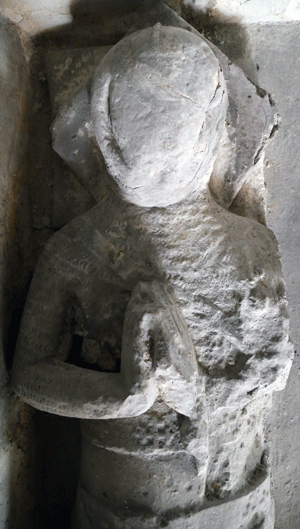 |
| Park outside in the village; may be tight.
Church open: dark interior, good toilets O/S Ref: SU 423 503 |
||
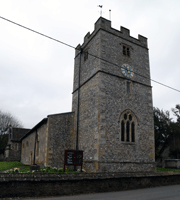
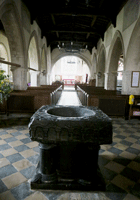 |
||
 |
||
| Called 'The Crusader Tomb' locally. Said to
be Sir Roger des Andelys of Wyke Manor, who was
killed in the Albegensian Crusade between 1209 - 1217. Effigy
installed c. 1330. The church was originally dedicated to St Mary but probably has a second dedication - to St Peter - from the 14th century. |
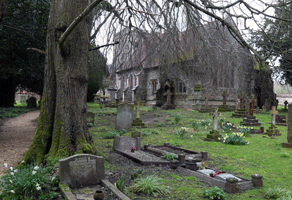 |
Thruxton - St Peter & St Paul |
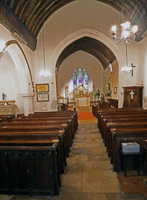 |
| Park ourside the church in the lane. The church may well be lock and the chancel is certainly locked and alarmed so it may well be advisable to contact the church before visiting. O/S Ref: SU 289 456 |
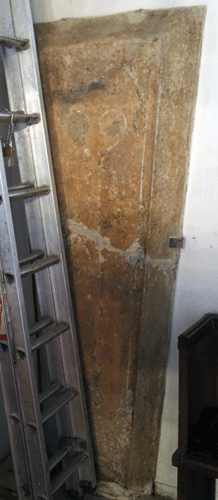 Above: Grave slab with foliated cross. This monument, as well as the medieval knight, are tucked away at the back of the church, one on either side, and easy to miss. They are partly covered in furniture and other items, some of which I was unable to move |
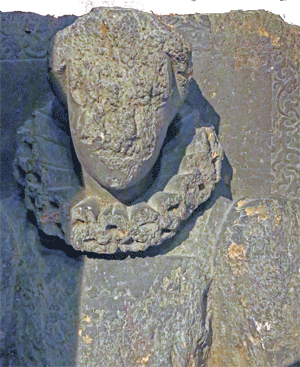 |
 |
 Above: Knight early 13th century. His shield lies on his breast and he seems to be wearing a pot helmet. Very worn and difficult to decipher.. |
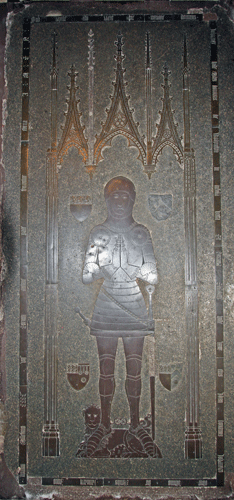 |
|
Above Left & Right: Effigy of an Elizabethan lady in
oak; very late for the use of wood for effigies. This effigy is hidden behind the choir stall in the locked and alarmed chancel so is easy to miss. Far Right: Brass to Sir John Lisle (1407) Very fine canopy and near complete. |
||||
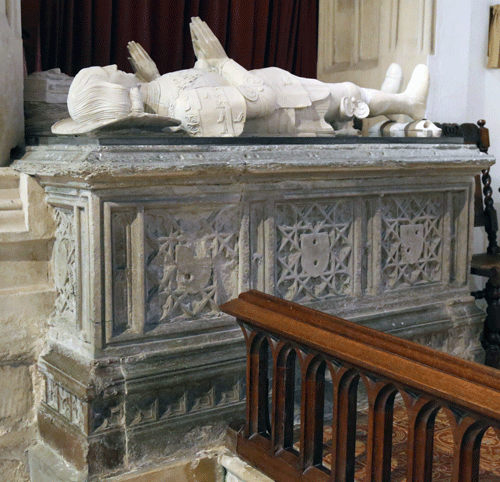 |
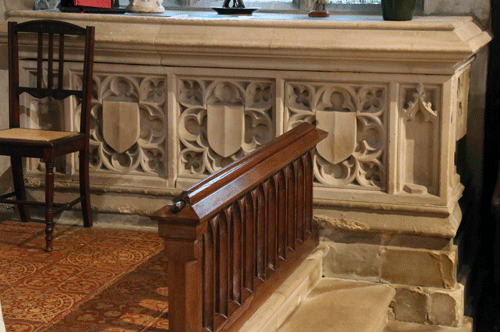
Above: Tomb chest, late 15th century
Left: Opposite the above tomb chest in the chancel is the monument to a member of the Lisle family and wife; c. 1520. The tomb chest is of Purbeck Marble while to effigies are of limestone. Below are details of the effigies. |
 |
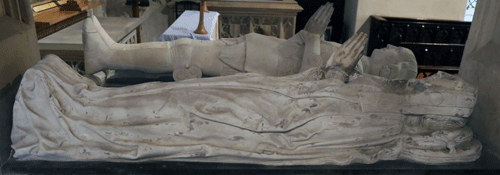 |
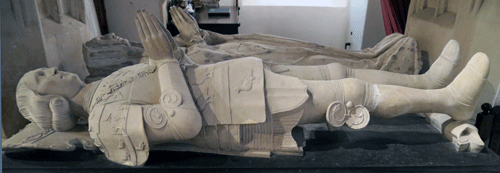 |
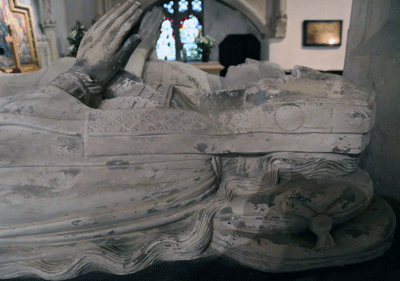 |